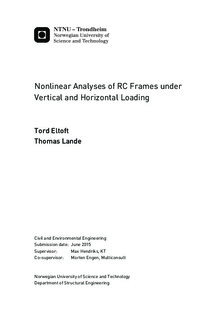| dc.description.abstract | The influence of the load history on the structural behaviour and capacity of some statically indeterminate reinforced concrete frames was investigated, through the use of nonlinear finite element analyses (NLFEA). The structural behaviour was evaluated in terms of ultimate capacity, development of crack regions, yielding of reinforcement, and closing of cracks.
Initially, a nonlinear model of the frames was established by performing a case study on a well documented experiment, and comparing analysis results to experimental data. Further, the established model was analysed in a series of virtual experiments, where three different loading paths were investigated. These three involved application of vertical and horizontal loads proportionally, and in sequence by varying which load was applied first. Also different ratios between the two loads were tested for each load path.
The established model was proved to give sufficiently good predictions for the ultimate capacity and the overall structural behaviour. However, the model behaved overly stiff in the initial phase of the analysis, which resulted in rather wrong predictions of the deflections. The reason for this behaviour could have been due to time dependent effects like drying-related shrinkage and so on.
The virtual experiments provided a thorough study of the structural behaviour of the frames under different loading paths. Expected structural behaviour, and differences in structural behaviour between the load paths, were observed. This was in terms of crack development, yielding of reinforcement, and closure of cracks resulting from changing direction of loading. The capacities differed somewhat between the load paths, though less than what was expected prior to conducting the analyses. The largest differences in capacity were found for large horizontal loads, relative to vertical loads. Hence, the load path with first application of the horizontal load resulted in the lowest capacity.
It was believed that the small differences in capacity could be a result of the chosen material models, and the fact that the full compressive strength of the concrete normal to the cracks, was restored upon crack closure. This was further investigated through two benchmark studies, and the results showed that a simple structure which had observed crack closure, showed an increase in strength and ductility, relative to a structure which had not experienced crack closure. This was an interesting finding, and further research investigating the mechanisms behind this increase in strength and ductility would be valuable. | |

